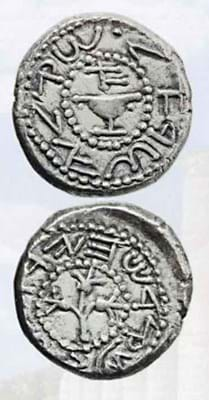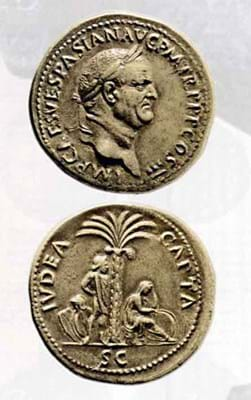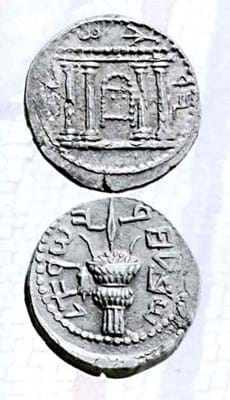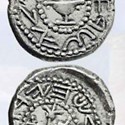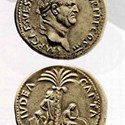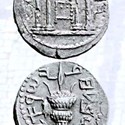Presented under the name of the Shoshana collection - perhaps to allow the vendor anonymity - the catalogue at the March 8-9 offering at Heritage Auctions (15% buyer's premium) did reveal that the owner was a Californian man who formed this significant collection over four decades.
For anything comparable to this 712-lot sale we have to go back 20 years to when the 913-lot Abraham Bromberg collection was sold in two tranches by Superior Galleries in New York in 1991 and 1992. Shoshana offered more coins of greater significance.
It says something for London as a numismatic centre that Heritage saw fit to bring this sale here for a preview.
Like classical Greek and Roman coins and the coins and medals issued by the papacy, those relating to Jewish history have global appeal. Other coins and medals tend to be collected on a national basis. Countries which have developed from an assemblage of small states into a larger nation are mainly only interested in their own ancient state. In Germany, for instance, the Frankfurter cares little for the Hamburger. The Swiss collect by cantons. You get the idea.
The diaspora means that the appeal of "Jewish" coins crosses many borders, and they also have crossover appeal because they are sought after by collectors who are not necessarily numismatists, such as Jewish historians.
The coins at Heritage fell into two main categories: those issued by Jewish authorities and those with themes relating to Jewish history.
An example of the second category was the 71AD bronze sestertius of Vespasian with the reverse legend: Judea Capta. The estimate was $60,000 (£38,200). It made $220,000 (£140,000). A variant sestertius estimated at $45,000 took $80,000 (£51,000). It was this campaign that provided the looted gold to construct the Colosseum in Rome.
The Jewish opposition to the Romans actually struck their own coins: silver shekels and fractions. They date from year one of the revolt to year five (66-70AD). The later the date the rarer they are. Year one is relatively common and there were three examples here. The most appealing example carried an estimate of $15,000 and sold for $8660 (£5500). These coins do turn up in most relevant sales.
An example of year two estimated at $12,000 took $7500 (£4780). One of year three carrying the same estimate realised $18,000 (£11,500). A year four piece, estimated at $40,000, fetched $32,500 (£20,700), while for the very rare year five, there were two examples, which took $220,000 (£140,000) and $150,000 (£95,500) respectively. The one that went for $220,000 had sold earlier in the Hunt sale at Sotheby's in June 1990, when it took $170,000 (then £101,190). It is said to have been found at Masada, that dreaded mount which was the scene of the mass suicide of the Jewish protestors against Roman rule in 73AD.
I cannot stop myself boasting of being on the Masada summit, a place of gaunt and majestic beauty, having walked from the shore of the Dead Sea, when attending the 1963 Jewish Numismatic Convention on the day that Yigael Yadin (the celebrated archaeologist - I met him on this day!) found six year five shekels. Sorry! Boast over.
These Masada shekels, defiantly inscribed Shekel of Israel, are a good example of coins that have a far wider appeal, beyond numismatics. The most spectacular of these shekels is the prototype of year one, of which there are only two known. One is in the Israel Museum at Jerusalem. The other was offered here with an estimate of $950,000. Having realised $220,000 (then £131,000) at the aforementioned Bromberg sale, this time out it took $925,000 (£590,000).
The coins (Son of the Star) of the Simon Bar Kokhba revolt against the Romans (132-135AD) come in much greater variety - there were 286 lots here - and are much more common. In the straitened times the Jews suffered, these coins were struck using existing coins of great variety. Perhaps the most emotive coin from this section of the sale was the silver sela (denomination) bearing an image of the Temple of Jerusalem, which had been destroyed in 70AD. It shows the Arc of the Covenant between the Temple's pillars and is defiantly dated year X of the Freedom of Israel - freedom from the forces of the Emperor Hadrian, of course.
Unlike the Masada coins, it is the earlier examples of these later coins that are rarer. A sela from the first year was estimated here at $30,000 and took $20,000 (£12,750). The Bromberg sale had seen this same example realise $11,500 (then about £6845). The Shoshana sale saw the dispersal of several of the later (year three) Temple selot. An equally appealing example estimated at $6500 took a bid of $7000 (£4460).
The total for this sale was $6.41m (£4.08m) and virtually every lot found a new cabinet. There were about 30 lots which failed, a very small proportion given the difficulty of arriving at estimates for coins whose individual appeal is often hard to judge.
Keep this catalogue, we shall (probably) not see its like again.

